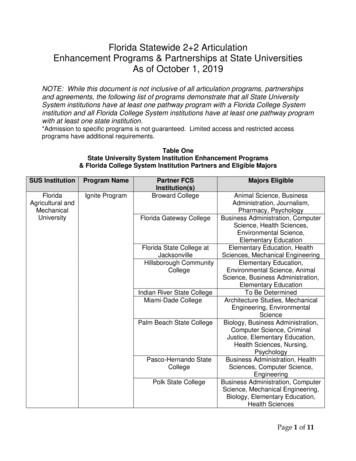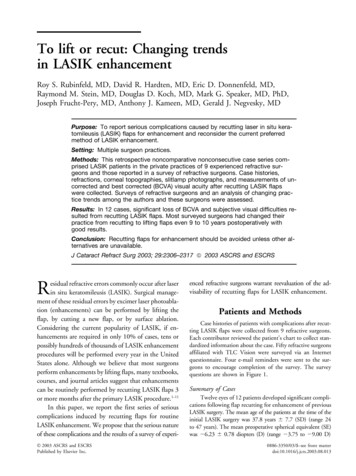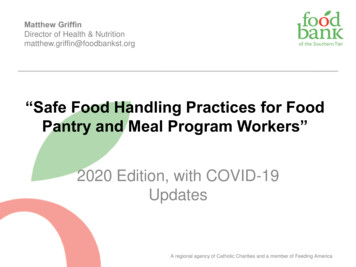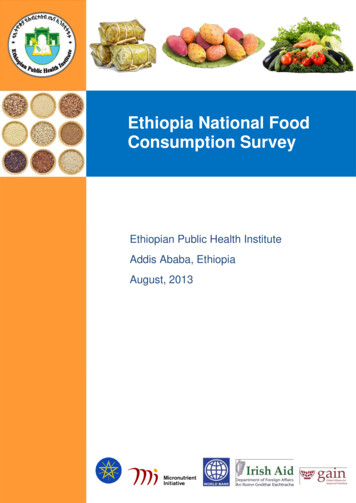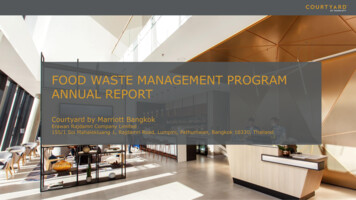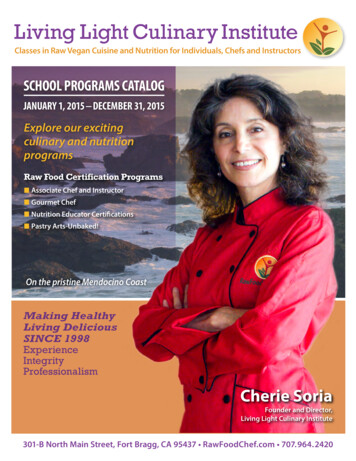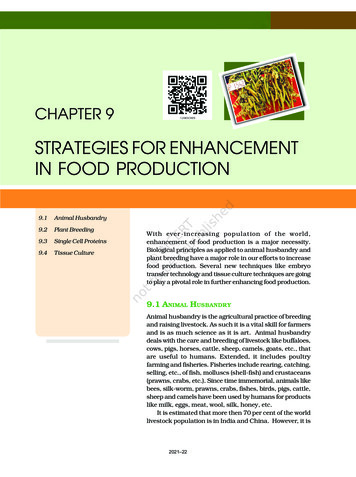
Transcription
CHAPTER 9STRATEGIES FOR ENHANCEMENTIN FOOD PRODUCTION9.1Animal Husbandry9.2Plant Breeding9.3Single Cell Proteins9.4Tissue CultureWith ever -increasing population of the world,enhancement of food production is a major necessity.Biological principles as applied to animal husbandry andplant breeding have a major role in our efforts to increasefood production. Several new techniques like embryotransfer technology and tissue culture techniques are goingto play a pivotal role in further enhancing food production.9.1 ANIMAL HUSBANDRYAnimal husbandry is the agricultural practice of breedingand raising livestock. As such it is a vital skill for farmersand is as much science as it is art. Animal husbandrydeals with the care and breeding of livestock like buffaloes,cows, pigs, horses, cattle, sheep, camels, goats, etc., thatare useful to humans. Extended, it includes poultryfarming and fisheries. Fisheries include rearing, catching,selling, etc., of fish, molluscs (shell-fish) and crustaceans(prawns, crabs, etc.). Since time immemorial, animals likebees, silk-worm, prawns, crabs, fishes, birds, pigs, cattle,sheep and camels have been used by humans for productslike milk, eggs, meat, wool, silk, honey, etc.It is estimated that more then 70 per cent of the worldlivestock population is in India and China. However, it is2021–22
BIOLOGYsurprising to note that the contribution to the world farm produce is only25 per cent, i.e., the productivity per unit is very low. Hence, in additionto conventional practices of animal breeding and care, newer technologiesalso have to be applied to achieve improvement in quality and productivity.9.1.1 Management of Farms and Farm AnimalsA professional approach to what have been traditional practices of farmmanagement gives the much needed boost to our food production. Let usdiscuss some of the management procedures, employed in various animalfarm systems.9.1.1.1 Dairy Farm ManagementDairying is the management of animals for milk and its products forhuman consumption. Can you list the animals that you would expectto find in a dairy? What are different kinds of products that can bemade with milk from a dairy farm? In dairy farm management, we dealwith processes and systems that increase yield and improve quality ofmilk. Milk yield is primarily dependent on the quality of breeds in thefarm. Selection of good breeds having high yielding potential (under theclimatic conditions of the area), combined with resistance to diseases isvery important. For the yield potential to be realised the cattle have to bewell looked after – they have to be housed well, should have adequatewater and be maintained disease free. The feeding of cattle should becarried out in a scientific manner – with special emphasis on the qualityand quantity of fodder. Besides, stringent cleanliness and hygiene (bothof the cattle and the handlers) are of paramount importance while milking,storage and transport of the milk and its products. Nowadays, of course,much of these processes have become mechanised, which reduces chanceof direct contact of the produce with the handler. Ensuring these stringentmeasures would of course, require regular inspections, with proper recordkeeping. It would also help to identify and rectify the problems as earlyas possible. Regular visits by a veterinary doctor would be mandatory.You would probably find it interesting if you were to prepare aquestionnaire on diverse aspects of dairy keeping and then follow it up witha visit to a dairy farm in your locality and seek answers to the questions.9.1.1.2 Poultry Farm Management166Poultry is the class of domesticated fowl (birds) used for food or for theireggs. They typically include chicken and ducks, and sometimes turkey andgeese. The word poultry is often used to refer to the meat of only these birds,but in a more general sense it may refer to the meat of other birds too.As in dairy farming, selection of disease free and suitable breeds,proper and safe farm conditions, proper feed and water, and hygiene andhealth care are important components of poultry farm management.2021–22
STRATEGIES FOR ENHANCEMENT IN FOOD PRODUCTIONYou may have seen TV news or read newspaper –reports about the ‘bird flu virus’ which created a scare inthe country and drastically affected egg and chickenconsumption. Find out more about it and discuss whetherthe panic reaction was justified. How can we prevent thespread of the flu in case some chicken are infected?9.1.2 Animal BreedingBreeding of animals is an important aspect of animalhusbandry. Animal breeding aims at increasing the yieldof animals and improving the desirable qualities of theproduce. For what kind of characters would we breedanimals? Would the selection of characters differ withthe choice of animals?What do we understand by the term ‘breed’? A groupof animals related by descent and similar in most characterslike general appearance, features, size, configuration, etc.,are said to belong to a breed. Find out the names of somecommon breeds of cattle and poultry in the farms of yourarea.When breeding is between animals of the same breed itis called inbreeding, while crosses between different breedsare called outbreeding.(a)(b)Figure 9.1 Improved breed ofcattle and chickens(a) Jersey (b) LeghornInbreeding : Inbreeding refers to the mating of moreclosely related individuals within the same breed for 46 generations. The breeding strategy is as follows – superior males andsuperior females of the same breed are identified and mated in pairs.The progeny obtained from such matings are evaluated and superiormales and females among them are identified for further mating. Asuperior female, in the case of cattle, is the cow or buffalo that producesmore milk per lactation. On the other hand, a superior male is the bull,which gives rise to superior progeny as compared to those of othermales.Try to recollect the homozygous purelines developed by Mendel asdiscussed in Chapter 5. A similar strategy is used for developing purelinesin cattle as was used in case of peas. Inbreeding increases homozygosity.Thus inbreeding is necessary if we want to evolve a pureline in any animal.Inbreeding exposes harmful recessive genes that are eliminated by selection.It also helps in accumulation of superior genes and elimination of lessdesirable genes. Therefore, this approach, where there is selection at eachstep, increases the productivity of inbred population. However, continuedinbreeding, especially close inbreeding, usually reduces fertility and evenproductivity. This is called inbreeding depression. Whenever this becomesa problem, selected animals of the breeding population should be mated2021–22167
BIOLOGYwith unrelated superior animals of the same breed. This usually helpsrestore fertility and yield.Out-breeding : Out-breeding is the breeding of the unrelated animals,which may be between individuals of the same breed but having nocommon ancestors for 4-6 generations (out-crossing) or betweendifferent breeds (cross-breeding) or different species (inter-specifichybridisation).Out-crossing: This is the practice of mating of animals within the samebreed, but having no common ancestors on either side of their pedigreeup to 4-6 generations. The offspring of such a mating is known as anout-cross. It is the best breeding method for animals that are belowaverage in productivity in milk production, growth rate in beef cattle,etc. A single outcross often helps to overcome inbreeding depression.Cross-breeding: In this method, superior males of one breed are matedwith superior females of another breed. Cross-breeding allows thedesirable qualities of two different breeds to be combined. The progenyhybrid animals may themselves be used for commercial production.Alternatively, they may be subjected to some form of inbreeding andselection to develop new stable breeds that may be superior to the existingbreeds. Many new animal breeds have been developed by this approach.Hisardale is a new breed of sheep developed in Punjab by crossingBikaneri ewes and Marino rams.Interspecific hybridisation: In this method, male and female animalsof two different related species are mated. In some cases, the progenymay combine desirable features of both the parents, and may be ofconsiderable economic value, e.g., the mule (Figure 9.2). Do you knowwhat cross leads to the production of the mule?168Controlled breeding experiments are carried out using artificialinsemination. The semen is collected from the male thatis chosen as a parent and injected into the reproductivetract of the selected female by the breeder. The semenmay be used immediately or can be frozen and used at alater date. It can also be transported in a frozen form towhere the female is housed. In this way desirable matingsare carried. Artificial insemination helps us overcomeseveral problems of normal matings. Can you discussand list some of them?Often, the success rate of crossing mature male andFigure 9.2 Mulefemale animals is fairly low even though artificialinsemination is carried out. To improve chances ofsuccessful production of hybrids, other means are also used. MultipleOvulation Embryo Transfer Technology (MOET) is one suchprogramme for herd improvement. In this method, a cow is administeredhormones, with FSH-like activity, to induce follicular maturation and superovulation – instead of one egg, which they normally yield per cycle, they2021–22
STRATEGIES FOR ENHANCEMENT IN FOOD PRODUCTIONproduce 6-8 eggs. The animal is either mated with an elite bull orartificially inseminated. The fertilised eggs at 8–32 cells stages, arerecovered non-surgically and transferred to surrogate mothers. The geneticmother is available for another round of super ovulation. This technologyhas been demonstrated for cattle, sheep, rabbits, buffaloes, mares, etc.High milk-yielding breeds of females and high quality (lean meat withless lipid) meat-yielding bulls have been bred successfully to increaseherd size in a short time.9.1.3 Bee-keepingBee-keeping or apiculture is the maintenance of hives of honeybees forthe production of honey. It has been an age-old cottage industry. Honeyis a food of high nutritive value and also finds use in the indigenoussystems of medicine. Honeybee also produces beeswax, which finds manyuses in industry, such as in the preparation of cosmetics and polishes ofvarious kinds. The increased demand of honey has led to large-scale beekeeping practices; it has become an established income generatingindustry, whether practiced on a small or on a large scale.Bee-keeping can be practiced in any area where there are sufficientbee pastures of some wild shrubs, fruit orchards and cultivated crops.There are several species of honeybees which can be reared. Of these, themost common species is Apis indica. Beehives can be kept in one’scourtyard, on the verandah of the house or even on the roof. Bee-keepingis not labour-intensive.Bee-keeping though relatively easy does require some specialisedknowledge and there are several organisations that teach bee-keeping.The following points are important for successful bee-keeping:(i) Knowledge of the nature and habits of bees,(ii) Selection of suitable location for keeping the beehives,(iii) Catching and hiving of swarms (group of bees),(iv) Management of beehives during different seasons, and(v) Handling and collection of honey and of beeswax. Bees are the pollinatorsof many of our crop species (see chapter 2) such as sunflower, Brassica,apple and pear. Keeping beehives in crop fields during flowering periodincreases pollination efficiency and improves the yield– beneficial bothfrom the point of view of crop yield and honey yield.9.1.4 FisheriesFishery is an industry devoted to the catching, processing or selling of fish,shellfish or other aquatic animals. A large number of our population isdependent on fish, fish products and other aquatic animals such as prawn,crab, lobster, edible oyster, etc., for food. Some of the freshwater fishes whichare very common include Catla, Rohu and common carp. Some of the marinefishes that are eaten include – Hilsa, Sardines, Mackerel and Pomfrets.Find out what fishes are commonly eaten in your area.2021–22169
BIOLOGYFisheries has an important place in Indian economy. It provides incomeand employment to millions of fishermen and farmers, particularly in thecoastal states. For many, it is the only source of their livelihood. In orderto meet the increasing demands on fisheries, different techniques havebeen employed to increase production. For example, through aquacultureand pisciculture we have been able to increase the production of aquaticplants and animals, both fresh-water and marine. Find out the differencebetween pisciculture and aquaculture. This has led to the developmentand flourishing of the fishery industry, and it has brought a lot of incometo the farmers in particular and the country in general. We now talk about‘Blue Revolution’ as being implemented along the same lines as ‘GreenRevolution’.9.2 PLANT BREEDINGTraditional farming can only yield a limited biomass, as food for humansand animals. Better management practices and increase in acreage canincrease yield, but only to a limited extent. Plant breeding as a technologyhas helped increase yields to a very large extent. Who in India has notheard of Green Revolution which was responsible for our country tonot merely meet the national requirements in food production but alsohelped us even to export it? Green revolution was dependent to a largeextent on plant breeding techniques for development of high-yielding anddisease resistant varieties in wheat, rice, maize, etc.9.2.1 What is Plant Breeding?170Plant breeding is the purposeful manipulation of plant species in order tocreate desired plant types that are better suited for cultivation, give betteryields and are disease resistant. Conventional plant breeding has beenpracticed for thousands of years, since the beginning of human civilisation;recorded evidence of plant breeding dates back to 9,000-11,000 years ago.Many present-day crops are the result of domestication in ancient times.Today, all our major food crops are derived from domesticated varieties.Classical plant breeding involves crossing or hybridisation of pure lines,followed by artificial selection to produce plants with desirable traits of higheryield, nutrition and resistance to diseases. With advancements in genetics,molecular biology and tissue culture, plant breeding is now increasinglybeing carried out by using molecular genetic tools.If we were to list the traits or characters that the breeders have tried toincorporate into crop plants, the first we would list would be increasedcrop yield and improved quality. Increased tolerance to environmentalstresses (salinity, extreme temperatures, drought), resistance to pathogens(viruses, fungi and bacteria) and increased tolerance to insect pests wouldbe on our list too.2021–22
STRATEGIES FOR ENHANCEMENT IN FOOD PRODUCTIONPlant breeding programmes are carried out in a systematic wayworldwide–in government institutions and commercial companies. Themain steps in breeding a new genetic variety of a crop are –(i) Collection of variability: Genetic variability is the root of anybreeding programme. In many crops pre-existing genetic variabilityis available from wild relatives of the crop. Collection and preservationof all the different wild varieties, species and relatives of the cultivatedspecies (followed by their evaluation for their characteristics) is apre-requisite for effective exploitation of natural genes available inthe populations. The entire collection (of plants/seeds) having allthe diverse alleles for all genes in a given crop is called germplasmcollection.(ii) Evaluation and selection of parents: The germplasm is evaluatedso as to identify plants with desirable combination of characters.The selected plants are multiplied and used in the process ofhybridisation. Purelines are created wherever desirable and possible.(iii) Cross hybridisation among the selected parents: The desiredcharacters have very often to be combined from two different plants(parents), for example high protein quality of one parent may needto be combined with disease resistance from another parent. This ispossible by cross hybridising the two parents to produce hybridsthat genetically combine the desired characters in one plant. This isa very time-consuming and tedious process since the pollengrains from the desirable plant chosen as male parent have to becollected and placed on the stigma of the flowers selected as femaleparent (In chapter 2 details on how to make crosses have beendescribed). Also, it is not necessary that the hybrids do combine thedesirable characters; usually only one in few hundred to a thousandcrosses shows the desirable combination.(iv) Selection and testing of superior recombinants : This stepconsists of selecting, among the progeny of the hybrids, those plantsthat have the desired character combination. The selection process iscrucial to the success of the breeding objective and requires carefulscientific evaluation of the progeny. This step yields plants that aresuperior to both of the parents (very often more than one superiorprogeny plant may become available). These are self-pollinated forseveral generations till they reach a state of uniformity (homozygosity),so that the characters will not segregate in the progeny.(v) Testing, release and commercialisation of new cultivars: Thenewly selected lines are evaluated for their yield and other agronomictraits of quality, disease resistance, etc. This evaluation is done bygrowing these in the research fields and recording their performanceunder ideal fertiliser application, irrigation, and other cropmanagement practices. The evaluation in research fields is followed2021–22171
BIOLOGYby testing the materials in farmers’ fields, for at least three growingseasons at several locations in the country, representing all theagroclimatic zones where the crop is usually grown. The material isevaluated in comparison to the best available local crop cultivar – acheck or reference cultivar.India is mainly an agricultural country. Agriculture accountsfor approximately 33 per cent of India’s GDP and employs nearly62 per cent of the population. After India’s independence, one of the mainchallenges facing the country was that of producing enough food for theincreasing population. As only limited land is fit for cultivation, India hasto strive to increase yields per unit area from existing farm land. Thedevelopment of several high yielding varieties of wheat and rice in themid-1960s, as a result of various plant breeding techniques led to dramaticincrease in food production in our country. This phase is often referredto as the Green Revolution. Figure 9.3 represents some Indian hybridcrops of high yeilding varieties.(a)(b)172(c)Figure 9.3 Some Indian hybrid crops: (a) Maize; (b) Wheat; (c) Garden peas2021–22
STRATEGIES FOR ENHANCEMENT IN FOOD PRODUCTIONWheat and Rice: During the period 1960 to 2000, wheat productionincreased from 11 million tonnes to 75 million tonnes while rice productionwent up from 35 million tonnes to 89.5 million tonnes. This was due to thedevelopment of semi-dwarf varieties of wheat and rice. Nobel laureateNorman E. Borlaug, at International Centre for Wheat and MaizeImprovement in Mexico, developed semi-dwarf wheat. In 1963, severalvarieties such as Sonalika and Kalyan Sona, which were high yielding anddisease resistant, were introduced all over the wheat-growing belt of India.Semi-dwarf rice varieties were derived from IR-8, (developed at InternationalRice Research Institute (IRRI), Philippines) and Taichung Native-1 (fromTaiwan). The derivatives were introduced in 1966. Later better-yielding semidwarf varieties Jaya and Ratna were developed in India.Sugar cane: Saccharum barberi was originally grown in north India, buthad poor sugar content and yield. Tropical canes grown in south IndiaSaccharum officinarum had thicker stems and higher sugar content butdid not grow well in north India. These two species were successfullycrossed to get sugar cane varieties combining the desirable qualities ofhigh yield, thick stems, high sugar and ability to grow in the sugar caneareas of north India.Millets: Hybrid maize, jowar and bajra have been successfully developedin India. Hybrid breeding have led to the development of several highyielding varieties resistant to water stress.9.2.2 Plant Breeding for Disease ResistanceA wide range of fungal, bacterial and viral pathogens, affect the yield ofcultivated crop species, especially in tropical climates. Crop losses canoften be significant, up to 20-30 per cent, or sometimes even total. In thissituation, breeding and development of cultivars resistant to diseaseenhances food production. This also helps reduce the dependence onuse of fungicides and bacteriocides. Resistance of the host plant is theability to prevent the pathogen from causing disease and is determinedby the genetic constitution of the host plant. Before breeding isundertaken, it is important to know about the causative organism andthe mode of transmission. Some of the diseases caused by fungi are rusts,e.g., brown rust of wheat, red rot of sugarcane and late blight of potato;by bacteria – black rot of crucifers; and by viruses – tobacco mosaic,turnip mosaic, etc.Methods of breeding for disease resistance: Breeding is carriedout by the conventional breeding techniques (described earlier) or bymutation breeding. The conventional method of breeding for diseaseresistance is that of hybridisation and selection. It’s steps are essentiallyidentical to those for breeding for any other agronomic characters suchas high yield. The various sequential steps are : screening germplasm2021–22173
BIOLOGYfor resistance sources, hybridisation of selected parents, selection andevaluation of the hybrids and testing and release of new varieties.Some crop varieties bred by hybridisation and selection, fordisease resistance to fungi, bacteria and viral diseases are released(Table 9.1).Table 9.1174CropVarietyResistance to diseasesWheatHimgiriLeaf and stripe rust, hill buntBrassicaPusa swarnim(Karan rai)White rustCauliflowerPusa Shubhra,Pusa Snowball K-1Black rot and Curlblight black rotCowpeaPusa KomalBacterial blightChilliPusa SadabaharChilly mosaic virus,Tobacco mosaic virusand Leaf curlConventional breeding is often constrained by the availability of limitednumber of disease resistance genes that are present and identified in variouscrop varieties or wild relatives. Inducing mutations in plants through diversemeans and then screening the plant materials for resistance sometimesleads to desirable genes being identified. Plants having these desirablecharacters can then be either multiplied directly or can be used in breeding.Other breeding methods that are used are selection amongst somaclonalvariants and genetic engineering.Mutation is the process by which genetic variations are createdthrough changes in the base sequence within genes (see Chapter 5)resulting in the creation of a new character or trait not found in the parentaltype. It is possible to induce mutations artificially through use of chemicalsor radiations (like gamma radiations), and selecting and using the plantsthat have the desirable character as a source in breeding – this process iscalled mutation breeding. In mung bean, resistance to yellow mosaicvirus and powdery mildew were induced by mutations.Several wild relatives of different cultivated species of plants have beenshown to have certain resistant characters but have very low yield. Hence,there is a need to introduce the resistant genes into the high-yieldingcultivated varieties. Resistance to yellow mosaic virus in bhindi(Abelmoschus esculentus) was transferred from a wild species andresulted in a new variety of A. esculentus called Parbhani kranti.2021–22
STRATEGIES FOR ENHANCEMENT IN FOOD PRODUCTIONAll the above examples involve sources of resistance genes that are inthe same crop species, which has to be bred for disease resistance, or in arelated wild species. Transfer of resistance genes is achieved by sexualhybridisation between the target and the source plant followed byselection.9.2.3 Plant Breeding for Developing Resistanceto Insect PestsAnother major cause for large scale destruction of crop plant and cropproduce is insect and pest infestation. Insect resistance in host crop plantsmay be due to morphological, biochemical or physiological characteristics.Hairy leaves in several plants are associated with resistance to insect pests,e.g, resistance to jassids in cotton and cereal leaf beetle in wheat. In wheat,solid stems lead to non-preference by the stem sawfly and smooth leavedand nectar-less cotton varieties do not attract bollworms. High asparticacid, low nitrogen and sugar content in maize leads to resistance to maizestem borers.Breeding methods for insect pest resistance involve the same steps asthose for any other agronomic trait such as yield or quality and are asdiscussed earlier. Sources of resistance genes may be cultivated varieties,germplasm collections of the crop or wild relatives.Some released crop varieties bred by hybridisation and selection, forinsect pest resistance are given in Table 9.2.Table 9.2CropVarietyInsect PestsBrassica(rapeseed mustard)Pusa GauravAphidsFlat beanPusa Sem 2,Pusa Sem 3Jassids, aphids andfruit borerOkra (Bhindi)Pusa SawaniPusa A-4Shoot and Fruit borer9.2.4 Plant Breeding for Improved Food QualityMore than 840 million people in the world do not have adequate food tomeet their daily food and nutritional requirements. A far greater number –three billion people – suffer from micronutrient, protein and vitamindeficiencies or ‘hidden hunger’ because they cannot afford to buy enoughfruits, vegetables, legumes, fish and meat. Diets lacking essentialmicronutrients – particularly iron, vitamin A, iodine and zinc – increasethe risk for disease, reduce lifespan and reduce mental abilities.2021–22175
BIOLOGYBiofortification – breeding crops with higher levels of vitamins andminerals, or higher protein and healthier fats – is the most practicalmeans to improve public health.Breeding for improved nutritional quality is undertaken with theobjectives of improving –(i)(ii)(iii)(iv)Protein content and quality;Oil content and quality;Vitamin content; andMicronutrient and mineral content.In 2000, maize hybrids that had twice the amount of the amino acids,lysine and tryptophan, compared to existing maize hybrids weredeveloped. Wheat variety, Atlas 66, having a high protein content, hasbeen used as a donor for improving cultivated wheat. It has been possibleto develop an iron-fortified rice variety containing over five times as muchiron as in commonly consumed varieties.The Indian Agricultural Research Institute, New Delhi has also releasedseveral vegetable crops that are rich in vitamins and minerals, e.g., vitaminA enriched carrots, spinach, pumpkin; vitamin C enriched bitter gourd,bathua, mustard, tomato; iron and calcium enriched spinach and bathua;and protein enriched beans – broad, lablab, French and garden peas.9.3 SINGLE CELL PROTEIN (SCP)176Conventional agricultural production of cereals, pulses, vegetables, fruits,etc., may not be able to meet the demand of food at the rate at whichhuman and animal population is increasing. The shift from grain to meatdiets also creates more demand for cereals as it takes 3-10 Kg of grain toproduce 1 Kg of meat by animal farming. Can you explain this statementin the light of your knowledge of food chains? More than 25 per cent ofhuman population is suffering from hunger and malnutrition. One of thealternate sources of proteins for animal and human nutrition is SingleCell Protein (SCP).Microbes are being grown on an industrial scale as source of goodprotein. Blue-green algae like Spirulina can be grown easily on materialslike waste water from potato processing plants (containing starch), straw,molasses, animal manure and even sewage, to produce large quantitiesand can serve as food rich in protein, minerals, fats, carbohydrate andvitamins. Incidentally such utilisation also reduces environmentalpollution.Certain bacterial species like Methylophilus methylotrophus, becauseof its high rate of biomass production and growth, can be expected toproduce 25 tonnes of protein. The fact that edible mushrooms are eatenby many people and large scale mushroom culture is a growing industry2021–22
STRATEGIES FOR ENHANCEMENT IN FOOD PRODUCTIONmakes it believable that microscopic fungiacceptable as food.too would become9.4 TISSUE CULTUREAs traditional breeding techniques failed to keep pace with demand andto provide sufficiently fast and efficient systems for crop improvement,another technology called tissue culture got developed. What does tissueculture mean? It was learnt by scientists, during 1950s, that wholeplants could be regenerated from explants, i.e., any part of a plant takenout and grown in a test tube, under sterile conditions in special nutrientmedia. This capacity to generate a whole plant from any cell/explant iscalled totipotency. You will learn how to accomplish this in higherclasses. It is important to stress here that the nutrient medium mustprovide a carbon source such as sucrose and also inorganic salts,vitamins, amino acids and growth regulators like auxins, cytokininsetc. By application of these methods it is possible to achieve propagationof a large number of plants in very short durations. This method ofproducing thousands of plants through tissue culture is called micropropagation. Each of these plants will be genetically identical to theoriginal plant from which they were grown, i.e., they are somaclones.Many important food plants like tomato, banana, apple, etc., have beenproduced on commercial scale using this method. Try to visit a tissuecu
High milk-yielding breeds of females and high quality (lean meat with less lipid) meat-yielding bulls have been bred successfully to increase herd size in a short time. 9.1.3 Bee-keeping Bee-keeping or apiculture is the maintenance of hives of honeybees for the production of honey. It has


